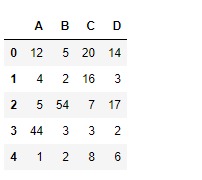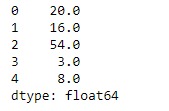Python是进行数据分析的一种出色语言,主要是因为以数据为中心的python软件包具有奇妙的生态系统。 Pandas是其中的一种,使导入和分析数据更加容易。
Pandas dataframe.max()函数返回给定对象中的最大值。如果输入是一个序列,则该方法将返回一个标量,该数量将是该序列中值的最大值。如果输入是一个 DataFrame ,则该方法将返回一个在 DataFrame 的指定轴上具有最大值的序列。默认情况下,该轴是索引轴。
用法: DataFrame.max(axis=None, skipna=None, level=None, numeric_only=None, **kwargs)
参数:
axis:{索引(0),列(1)}
skipna:计算结果时排除NA /空值
level:如果轴是MultiIndex(分层),则沿特定级别计数,并折叠为Series
numeric_only:仅包括float,int,boolean列。如果为None,将尝试使用所有内容,然后仅使用数字数据。未针对系列实施。
返回:max:Series或DataFrame(如果指定级别)
范例1:采用max()函数在索引轴上查找最大值。
# importing pandas as pd
import pandas as pd
# Creating the dataframe
df = pd.DataFrame({"A":[12, 4, 5, 44, 1],
"B":[5, 2, 54, 3, 2],
"C":[20, 16, 7, 3, 8],
"D":[14, 3, 17, 2, 6]})
# Print the dataframe
df
让我们使用dataframe.max()查找索引轴上最大值的函数
# Even if we do not specify axis = 0,
# the method will return the max over
# the index axis by default
df.max(axis = 0)输出:

范例2:采用max()在具有Na值。还要找到纵轴上的最大值。
# importing pandas as pd
import pandas as pd
# Creating the dataframe
df = pd.DataFrame({"A":[12, 4, 5, None, 1],
"B":[7, 2, 54, 3, None],
"C":[20, 16, 11, 3, 8],
"D":[14, 3, None, 2, 6]})
# skip the Na values while finding the maximum
df.max(axis = 1, skipna = True)输出:

相关用法
- Python pandas.map()用法及代码示例
- Python Pandas Series.str.len()用法及代码示例
- Python Pandas.factorize()用法及代码示例
- Python Pandas TimedeltaIndex.name用法及代码示例
- Python Pandas dataframe.ne()用法及代码示例
- Python Pandas Series.between()用法及代码示例
- Python Pandas DataFrame.where()用法及代码示例
- Python Pandas Series.add()用法及代码示例
- Python Pandas.pivot_table()用法及代码示例
- Python Pandas Series.mod()用法及代码示例
- Python Pandas Dataframe.at[ ]用法及代码示例
- Python Pandas Dataframe.iat[ ]用法及代码示例
- Python Pandas.pivot()用法及代码示例
- Python Pandas dataframe.mul()用法及代码示例
- Python Pandas.melt()用法及代码示例
注:本文由纯净天空筛选整理自Shubham__Ranjan大神的英文原创作品 Python | Pandas dataframe.max()。非经特殊声明,原始代码版权归原作者所有,本译文未经允许或授权,请勿转载或复制。
